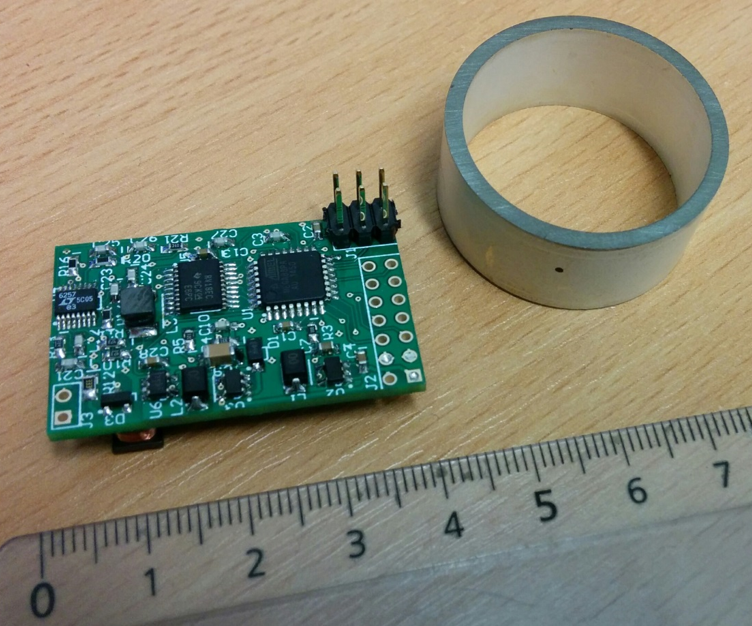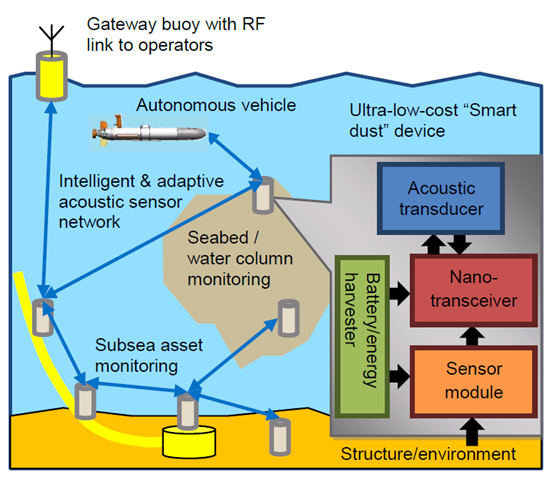About USMART
 The aim of this project is to create a smart underwater sensing framework based on ultra-low-cost wireless communication and sensing nodes (‘smart dust’). Pilot studies at Newcastle University have demonstrated the feasibility of producing underwater acoustic communication devices known as “nanomodems” (pictured) which use novel, sparse signal processing approaches to vastly reduce hardware complexity, size and cost. These have manufacturing cost as low as £50, receiver power consumption less than 10mW and tiny dimensions but achieve data transfer and positioning capabilities, up to 2km range, found in much more expensive devices. This base technology will be expanded by investigating new modulation schemes to maximise communication efficiency and low cost sensor modules will be developed, along with flexible interfaces for commercial sensors, to create mass deployable wireless sensor nodes. These will be combined with energy efficient multiple access network protocols based knowledge of the underwater channel (University of York) and intelligent, sparse sensing/localisation algorithms (Heriot Watt University). This will deliver resilient underwater acoustic sensor networks (UASN) for persistent monitoring with high spatio-temporal sampling rate and near real time data delivery.
The aim of this project is to create a smart underwater sensing framework based on ultra-low-cost wireless communication and sensing nodes (‘smart dust’). Pilot studies at Newcastle University have demonstrated the feasibility of producing underwater acoustic communication devices known as “nanomodems” (pictured) which use novel, sparse signal processing approaches to vastly reduce hardware complexity, size and cost. These have manufacturing cost as low as £50, receiver power consumption less than 10mW and tiny dimensions but achieve data transfer and positioning capabilities, up to 2km range, found in much more expensive devices. This base technology will be expanded by investigating new modulation schemes to maximise communication efficiency and low cost sensor modules will be developed, along with flexible interfaces for commercial sensors, to create mass deployable wireless sensor nodes. These will be combined with energy efficient multiple access network protocols based knowledge of the underwater channel (University of York) and intelligent, sparse sensing/localisation algorithms (Heriot Watt University). This will deliver resilient underwater acoustic sensor networks (UASN) for persistent monitoring with high spatio-temporal sampling rate and near real time data delivery.

With highly flexible sensor payloads, the technology created will have generic application across a wide range of monitoring tasks. However, the project will focus on 3 demonstrator scenarios in close collaboration with industry & end users:
-
subsea asset monitoring e.g. subsea cables, risers, seabed installations
-
marine environment / biodiversity monitoring
-
sensor nets for underwater security
The key novel contributions of this project will be:
-
Disruptive, low-cost technology enabling mass deployment with battery life of several years.
-
Large scale underwater monitoring (>100 devices) with high spatio-temporal sampling rate.
-
Rapid deployment and near real time data delivery (as opposed to data logging).
-
Intelligent, adaptive sensing to maximise resource utilisation and fully exploit large scale.
To maximise the impact of the project, an open testbed will be created near the Northumberland coast. Potential end-users from across the subsea sector will be invited to take part in a series of workshops to identify new opportunities in distributed underwater sensing, which will be prototyped to enable feasibility studies/demonstrations via trials using the testbed. The ultimate measurable objective of the project will be to demonstrate a step change in the efficiency of subsea data gathering. This will be defined in terms of the data output (volume, quality, coverage) versus overall cost (hardware cost, boat time, staff time, infrastructure cost).



